Stop 1: Red Mountain
We started our last day of the trip (cue tears) at 8 am with a delectable parking lot breakfast and a speedy sandwich-making session before heading off towards Flagstaff.
Our first stop was Red Mountain, which is a cinder cone north of Flagstaff. Red Mountain is one of over 600 volcanoes in the San Francisco Volcanic Field (SFVF) that were produced within the last 6 million years. We emerged from the vans to gusts of wind and Arlo’s assurances that this would be an easy nature stroll. It. Was. Not. We trudged through over 1.5 miles of waist deep snow drifts to get to the cinder cone’s cross section. Luckily, this cross section was exceptionally clear, allowing us to see the layers of lava that had created it. On our journey in, we passed by a handful of volcanic bombs. These 0.5-1 meter large bombs were partially molten rocks ejected during an eruption into the surrounding environment. They stood out starkly against the white landscape, leading the intrepid junior geologists of the group to wonder how on Earth they had gotten there.
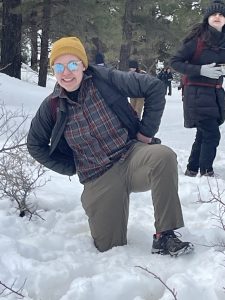
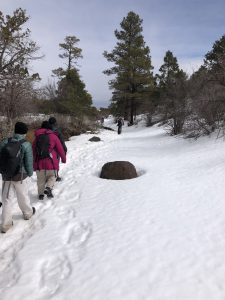
Before venturing forward, let’s define what a cinder cone is. When low-silica basaltic magma forms a volcano, the material is lower in viscosity to a felsic volcano. When a cinder cone volcano erupts, it does so dramatically, with material shooting up out of the main vent and falling down quickly due to gravity. Don compared this to popcorn expanding on a stove: fast, hot and snappy! Cinder cones are typically very quick events, by geologic standards – on the scale of months to years. Basaltic magmas erupt by finding the path of least resistance, which is usually through fractures- either that the magma makes, or pre-existing ones.
The Red Mountain cinder cone erupted in a single, years-long event along a large normal fault around 5 or 6 million years ago. The high amount of groundwater in the surrounding area steamed and expanded when the magma got close to it, making the eruption even more explosive. Arlo was clear to say that there is very little ash in these deposits; it’s mostly scoria and pyroclastic material. Ash is not usually found with basaltic cinder cones, so don’t you dare tell him that it is!
After almost disappearing in the snow, we arrived at the base of Red Mountain and clambered around for a bit, taking notice of all the geologic features and just how easy it was to slip down the slopes and bump your butt (official geologic term: asymptotic bottom). We saw layers in the cone that were parallel to the shape of the mountain, defining its shape and representing the phases of the eruption.
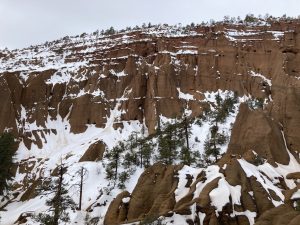
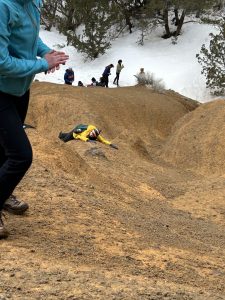
Arlo explained that something has to cause these layers, specifically the color changes. One explanation could be that some layers were more welded than others, meaning some of the erupting material was hotter, and when it was deposited it stuck together much faster than the relatively colder material could have. Don added the vivid image that it would have been a volcano spewing out red hot cinder. This is real scary stuff, you guys! We also took note of the material: it was vesicular basalt, with lots of iron and magnesium. The grains were well rounded as a result of spewing out of the volcano and falling back down as little blobs.
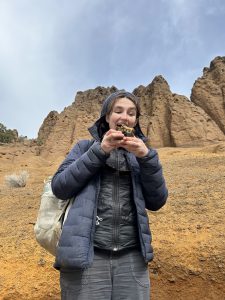
We found pyroxene, plagioclase, obsidian (!!), zeolites in the big spaces (aka vugs) of the rocks.
These rocks look like palagonites, which are a mush of lots of phyllosilicates, as Selby put it. This is what mafic material weathers to (thank you, mineralogy).

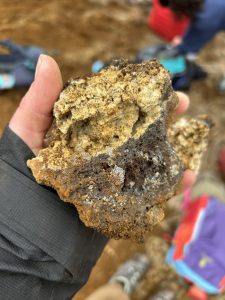
Don, always bringing in the invaluable seds aspect, explained that the prevailing wind now and at the time the volcanoes erupted was from the south west. So the material from them was blown to the north east, and should be steeper on that side – which it is, and is exemplified by the fact that that is the side where it failed. This is why we get the great exposed cross section!
We also saw some hoodoos and canyons, but were not able to traverse them because of the snow and our soggy feet. Arlo let us know that both of these are erosional features just like the ones we saw in Utah earlier in our trip! On our walk back to the vans, some of us got a bit wild and engaged in some snowball warfare. Luckily, all of us emerged unscathed, even though a few innocent bystanders were caught in the crossfire.
Stop 2: Sunset Crater
We arrived at Sunset Crater National Monument to view the sharp lava flows and the well-exposed surface of Sunset Crater. Our first stop was a field of rough lava named the Bonita flow. Native Hawaiians have named this type of spiky lava a’a because of the sound one would make walking over it barefoot. AH! OWIE! Luckily, all of us had appropriate footwear, which kept the quick walk to the back of the field free from any yelps of pain. We came upon a wall of massive basaltic boulders, which we immediately began to clamber over, ignoring the instructions of the kind rangers we met at the visitor’s center. We were reminded by Arlo that this was our last geologic stop of the trip, and we must actually look at the rocks if we have any hope of becoming real, grown-up geologists. Students noted that these boulders were peppered with holes, or vesicles, a common feature in basalts that have been extruded above the Earth’s surface. These vesicles were more numerous towards the top of the boulders, a result of air bubbles rising through the low-density hot lava to form a froth. Basaltic lava cools quickly, meaning that any air pockets trapped within are preserved in the geologic record. Within these boulders, we identified pyroxene, olivine, zeolites (less than at Red Mountain), and the same mysterious clear crystals from our previous stop. These are all common minerals to find in a mafic site like Sunset Crater.
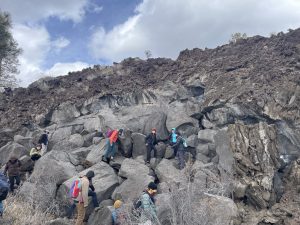
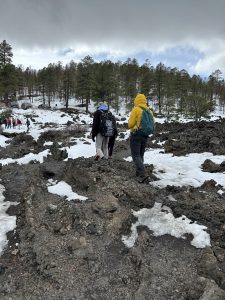
We noticed a small collapsed lava tube that was formed when the outside of a lava vent cooled quicker than the inside. The lava spewing out of the vent continued to flow until it ran dry, leaving a cavity behind. Some lava tubes are large enough to drive a car through, but this one was too small for even the tiniest undergrad to fit inside.
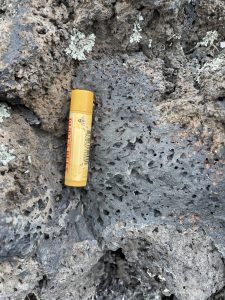
Our discussion then turned to the relative age of Sunset Crater. We brainstormed some possible dating mechanisms for the eruption and suggested carbon-14 dating to our profs. This was quickly shot down, as C-14 dating requires carbon-rich material and the vast majority of organic substances were (understandably) incinerated by lava flows. Interestingly, imprints of some flora are preserved within the lava. Casts of corn have been found, allowing researchers to extrapolate that the eruption likely began in the fall, after the yearly harvest had ended. Additionally, some carbon-containing pottery from the area was tempered with material from the lava flows, allowing for closer time estimations. The best method of dating an eruption like the one that created Sunset Crater, however, uses paleomagnetic secular variation. Amazingly, our lovely comrade in arms Ro knew this all on their own!
- Arlo: Does ANYONE have an idea of how this cinder cone could be dated?
- Ro: Paleomagnetic secular variation?
- Arlo: Dammit, you’re making my knees weak!
Sunset crater is the most recent eruption in the San Francisco Volcanic Field, and erupted around 1040 to 1100 CE. Around 30 million years ago the Farallon Plate detached from right under the North American plate, and continued its descent in the mantle. The lower part of the North American plate had all the volatiles from the oceanic Farallon plate, and once it came into contact with the asthenosphere, it produced a huge amount of volcanism all over the Rocky mountains.
Around 6 million years ago, the lower part of the lithosphere of North America fell off – this is called delamination. This is one of the main drivers of the uplift of the Colorado Plateau, which happened in the last 6 to 8 million years. At the Plateau, the lithosphere is 150 km thick, whereas at the basin and range, which is right next to it, it’s only 70 km. This is an enormous relief difference in the asthenosphere. The SFVF was a fissure eruption, with 10 km of material spewing out. The older volcanoes are on the west of the fissure, and the youngest on the east. The movement of this eruption is not due to hotspot movement, but might be because of plate motion. There is a concentration of younger eruptions at the edge of the Colorado Plateau, which could be connected to the asthenospheric heat movements and topographic differences between the basin and range and the Plate. But ultimately, we aren’t really sure why this happened.
We hopped back in our vans for a short drive to a small path closer to Sunset Crater, where we met a lovely park volunteer. He offered to give us an impromptu history lesson, which we of course accepted. He told us how in 1929, a film crew wanted to blow up Sunset Crater to make an avalanche movie. As you can imagine, this did not go over well! After much uproar from the surrounding community, Herbert Hoover (a fellow geology major) established Sunset Crater National Monument to protect the landscape against any explosive assaults. In return for this lecture, the volunteer got $21 ($1 for each visitor he talked to). We love a symbiotic relationship!

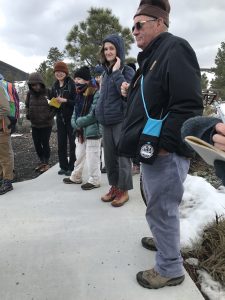
On an unrelated note, Don told Aidan to sniff the trees. So he did. So did a couple other people. He said they smelled like butterscotch, and apparently they did. Yes, we know this is not a biology trip, but let us sniff our trees dammit!
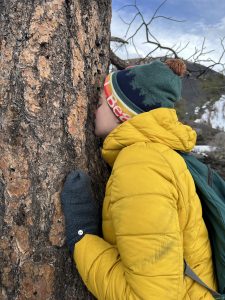

To sum up the volcanology in the San Francisco Volcanic Field (hence our title name!): Ultramafic peridotite is found within Earth’s mantle. Upward flow of the mantle causes partial melt and creates mafic basalt because of decompression melting. Basaltic melt goes through granitic continental material and becomes more felsic. Now we bring in Bowen’s reaction series – real fun stuff here!! Essentially, different minerals melt and crystallize at different temperatures. The first to melt are quartz, muscovite, and plagioclase – basically granite. In contrast, the first to precipitate are olivine and calcium plagioclase. SO! If mantle magma rises into continental crust and erupts as is you’ll get a basalt rock. Makes sense! If mantle magma rises and partially melts the surrounding felsic rock, you can get magma assimilation, which is just a fancy way to say the different magmas mix. If they mix, you get an intermediate magma through fractional crystalisation, and if they don’t mix, the felsic melt can erupt and make some felsic nonsense next to the basalts, which we see in the SFVF, where all three types are next to each other. (We were supposed to go over this during the car wash, but didn’t. Thanks Arlo… but Selby got our back :))

TL;DR: We see basalt rocks, intermediate rocks, and rhyolite domes in the SFVF! Right next to each other! Wow!
Stop 3: Car Wash
Unfortunately, we didn’t end up seeing the Pueblo ruins in the Wupatki National Monument due to high wind speeds and blocked trails. Our final unofficial stop was a car wash in Flagstaff. We needed to conceal any evidence that we had been off roading in the (formerly) nice, shiny rental vans, so we got to work with water sprayers, lots of soap, and coin-operated vacuums. By the end, we had gotten the vehicles back to a state that would not incur us any more fines than we had likely already racked up.
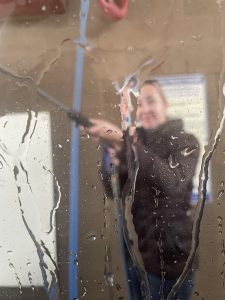
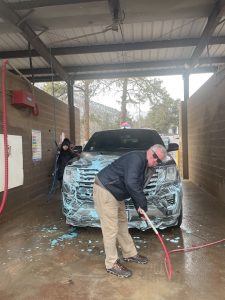
Then it was time for the 2.5 hour drive back to Phoenix. Florence the Machine (Selby’s car) had a lovely trip full of Taylor Swift and Broadway sing-alongs, Albanese gummy worms, license plate analysis, and naps (pictured below).
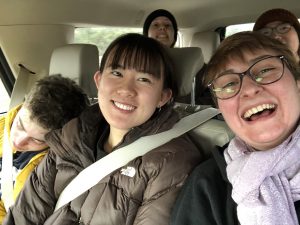
Much Geo Love,
Your intrepid bligoors
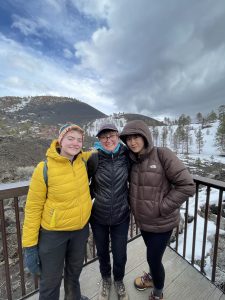
Quote of the day:
Arlo: Be light on your feet like a Kung Fu master! Hey, Don, do you know that Kung Fu guy who masturbated himself to death?
Don: Bruce Lee?
Arlo: NO!
*Arlo proceeds to repeat the question, Don repeats Bruce Lee, students roll eyes and groan as this goes on for several more rounds*
Number of snowball fights: 2. This was not play; this was war.
Number of fun license plates on the highway: 5. “DOG♥ER” zoomed away too fast before we were able to get photo evidence (presumably to reunite with Toto) but we are counting them in our tally.
Number of Ponderosa Pine trees sniffed: 2.
Number of T-Swizzle songs sung: too many to count! Selby, you are such a trooper.
One response to “Day 7: The Volcanology Smörgasbord”
The articles you write help me a lot and I like the topic